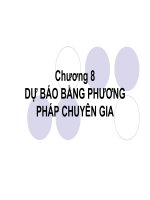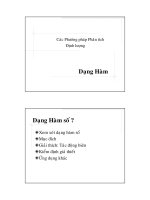Slide research ideas and econometric models dự báo kinh tế và phân tích dữ liệu
Bạn đang xem bản rút gọn của tài liệu. Xem và tải ngay bản đầy đủ của tài liệu tại đây (188.63 KB, 36 trang )
Research Ideas and
econometric models
Nguyễn Hoàng Bảo
Outline
1. A Logistic Regression Model of Drop out of
High School
2. A Logistic Model of Rural–Urban Migration
3. Choice of domestic or foreign product
4. A Multinomial Logistic Regression Model of
Determinants of Divorce
5. Who receives remittances
6. How to construct demand for a single good
7. Who smokes cigarettes
1. A Logistic Regression Model of
Drop out of High School
•
Droup out of school is, of course, not occurred
randomly.
•
There are many factors which might affect the
problem of drop out prematurely.
•
Dependent variable: Drop out? (Y=1)
•
Independent variables: If the positive/negative
sign of the specific explanatory variable means
increase/decrease the probability of dropout and if
the question mark of the specific explanatory
variable means that there is no clear pattern.
There are four groups of explanatory variables.
Individual characteristics
•
Gender (?)
•
Age (+)
•
Intellectual Quality Index (IQ) (-)
•
Bad health/Malnutritional status (+)
•
Grade repetition (+)
•
Indulgence in playing (+)
•
Child work (+)
•
Married child (+)
Family characteristics
•
Household income/expenditure (-) (b)
•
Agricultural land used (-)
•
Education of parents (-)
•
Tastes of education of parents, little parental
concern (-)
•
Number of children (+)
•
Marital status of parents: living together, being
divorced, being separated, being widowed (?)
School characteristics
•
School fees charged (+)(c)
•
Distance to school (+)
•
Teacher educational level (-)
•
Teacher experience (-)
•
Teacher motivation (-)
•
Pedagogical techniques used (?)
•
Condition of school building (-)
•
Availability of learning materials (textbooks) (-)
•
Quality of learning materials (-)
•
Characteristics of head of school (?)
•
Hours and days that school is opened (-)
•
Number of pupils in the class, and/or teachers/students ratio, space
for each pupils (proxy measurement of quality of schooling) (-)
Regional characteristics
•
Urban/rural (-)
•
Kinh/ethnics (-)
•
Use/do not use Vietnamese language (-)
•
No demand for studying (+)
•
Hiện nay, hiện trạng đất nước thay đổi, nhưng
với chính sách xã hội hóa giáo dục, liệu những
mảnh đời bất hạnh vì bỏ học, có ai quan tâm
không? Ngoài chúng ta ra còn ai nữa không?
Chính quyền địa phương hả, hỏi họ thử coi, họ
trả lời vấn đề này ra sao?
2. A Logistic Model of Rural–Urban
Migration
•
Life migration equation
M = f(α)
α = Y
U
– Y
R
∫
∫
=
−
=
−
=
−=
n
t
rt
R
R
n
t
rt
U
U
dt
dt
e
t
Y
Ce
t
Y
0
0
0
)(
)(
ω
ω
3. Choice of domestic or foreign
product
•
Characteristics of consumer
–
Income/Expenditure
–
Age
–
Gender
–
Education
–
Urban/rural
•
Characteristics of product
–
Price and quality
4. A Logistic Regression Model of
Determinants of Divorce
•
Age
•
Age gap
•
Income
•
Income gap
•
Education
•
Educational gap
•
Religion
•
Number of children
•
Being single of relatives
•
Marital status of parents
•
Job characteristics (out of sight, out of mind)
•
Social ties
5. Who receives remittances
•
Self–adjustment mechanism
•
Community and family spirit
5. Who receives remittances
•
Household size (-)
•
I head male? (Yes=1) (-)
•
Is head employed? (-) (causality flows?)
•
Regional effects (Ho Chi Minh, Hue, and Da Nang)
•
Education spending per capita (+)
•
Health spending per capita (+)
•
Age of head of household (+)
•
Per cent household of working age (-)
•
Number of children (-)
•
Urban (+)
6. How to construct demand for a
single good
17
P
Law of demand
Q
Q
D
(given income)
P ↑ ⇒ Q ↓
P ↓ ⇒ Q ↑
Are there any exceptional cases?
18
Demand function (Q
D
)
•
Price (-)
•
Price of substitution products (+)
•
Price of complementary products (-)
•
Income per capita (?)
•
Advertising costs (+)
•
Tastes (?)
•
Desire (+)
•
Externality network (?)
•
Seasonal/Cyclical affects
Characteristics of good
•
Durable or undurable good
•
Expensive or unexpensive good
•
Storage or nonstorage good
•
Fashionable or unfashionable good
•
Necessary or unnecessary good
•
Inferior, common, and luxury good
•
Material or spirit good
•
Cultural or non–cultural values
•
Standardized or unstandardized good
21
Rich/poor response to the demand
For the common products, when income
increases, the poor may consume more and the
rich may consume less (rice)
Q
D
= a
0
+ a
1
Y + a
2
Y
2
where Q
D
is demand and Y is income per
capita. The expected sign of the coefficient a
1
is positive and a
2
is negative
22
Demand function (1)
lnQ
D
= a + b
j
(P
j
/P
i
) + … + b
k
(P
k
/P
i
) + c ln(Y/P
i
) +
other variables
Q
D
is the demand of rice (quantity)
P
i
is the price of rice
P
j
…P
k
are the price of other products
Y is the income per capita
23
Demand function (2)
lny
i
= a + b
i
lnP
i
+ c
i
lny + d
i
(lny)
2
+ e
i
(lnP
i
. lny) + f
i
ln(P
index
)
+ g
i
other variables
y
i
is spending on rice
P
i
is the price of rice
y is total expenditure or income per capita
lnP
i
.lny captures the structural change of consumption
effects
P
index
is the consumer price index
24
Elasticity of demand with respect to
its own price
E = (%ΔQ
D)
/ (%ΔP)
If E=-0.2, when price increases 1%, demand
decreases 0.2%
25
Elasticity of demand with respect to
income
E = (%ΔQ
D)
/ (%ΔY)
If E=0.6, when income per capita increases 1%,
demand increases 0.6%
If E=-0.2, when income per capita increases 1%,
demand decreases 0.2% (the good is inferior
ones)









